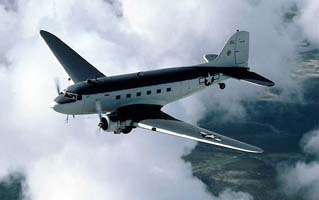Douglas R4D-6S
U.S. Navy Transport & Air-Sea Warfare
 |
The Ghost Squadron's R4D-6S was equipped with radar and other
electronics for submarine hunting. Image source: The Confederate Air Force Ghost Squadron CD-ROM produced by Corel. Photos by Bill Crump. |
Developed from the commercial DC-3 airliner, the Douglas transport went to war with the Army Air Corps as the C-47 and with the Navy and Marine Corps as the R4D.
First ordered for the Navy in 1941, the R4D-1 was a cargo transport and served as the basic equipment for the Naval Air Transport Service (NATS), which was created on 12 December, 1941. In 1942, the South Pacific Combat Air Transport Service was formed, and used R4Ds to carry supplies into combat zones and airlift casualties out. In one month, over 22,000 passengers, 3,300,000 pounds of freight and 941,000 pounds of mail were delivered by this unit.
In addition to normal transport duties, R4Ds were equipped for various specialized roles, indicated by a special letter suffix added to their basic designation. For example, an R4D-4Q was fitted for radar countermeasures; the R4D-5E carried special electronics equipment; the R4D-5T was a navigation trainer; the R4D-5Z an executive or VIP transport and the R4D-6S was equipped for air-sea warfare training.
The CAF's R4D-6S was one of only about 30 of this model specifically built for air-sea warfare. It carried the most modern air-to-surface radar available, and some of the early style radar antennas can be seen under the rear fuselage and on the sides of the nose, beneath the cockpit windows.
In addition to air-sea warfare training, some R4D-6Ss saw actual combat. Records of these air-sea warfare operations are still classified secret, however, this aircraft's squadron is credited with sinking a German U-boat in the Atlantic.
Purchased by sponsors in the early 1980s and donated to the CAF Ghost Squadron, the plane was restored to its original World War II appearance both inside and out over several years by members of its support team in the Dallas/Fort Worth area. Even the original radio sets have been cosmetically restored and fitted in the radio operator's station.
The aircraft is painted in the Atlantic over-water camouflage scheme, designed to make it blend with the dark grey water from above and the white clouds from below.
In 1985, this R4D, named "Ready 4 Duty", flew from Texas, across the Atlantic ocean, to Great Britain and the Netherlands to represent the CAF at the 50th anniversary celebration of the DC-3/C-47/R4D/Dakota aircraft.
Manned by a crew of CAF volunteers, the aircraft not only completed the journey safely but was awarded a prize for the best restored military version at the display.
Specifications
Crew of Three to Five Hamilton Standard Up to 27 passengers or 10,000 lbs Four aerial depth charges or bombs Max. Speed 224 mph @ 10,000 ft |
Initial climb rate 940
ft/min Length 63' 9" Max. Weight 31,000 lbs Normal Range 1,600 miles |